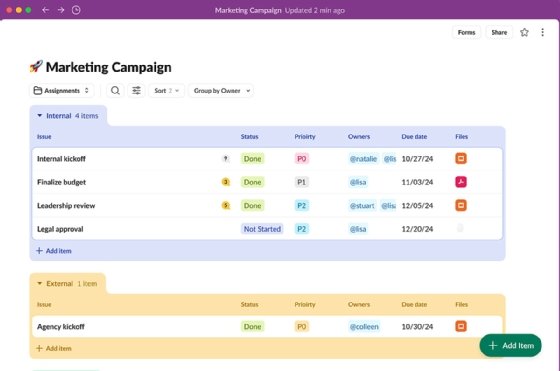
Rawpixel.com - stock.adobe.com
Slack lists drops, edging it ever closer to project management
Slack isn't a full-fledged project management platform. But new features help users organize, assign and track tasks as they would in more sophisticated clouds.
Slack, owned by Salesforce, introduced new project-management tech today with the release of lists. But long-established project management platforms shouldn't be worried quite yet.
Slack lists, previewed last year at Dreamforce, finds tasks in typed and video conversations and can assign, set deadlines and track them. Some of the routine "projects" Slack lists could manage include the steps of employee onboarding, individual marketing campaigns and technology deployments across an enterprise.
While it's not project management software per se, Slack lists can capture and assign project-critical tasks that might otherwise fall by the wayside. This happens because they are typed in Slack messages; spoken in Slack video Huddles; or written in Slack Canvas, a digital workspace with workflow automation tools and project-milestone checklists.
Slack lists provides individual task management workflows and is less suited for whole project management in an enterprise setting, Constellation Research analyst Liz Miller said. But in large enterprise environments, those tasks can be seen and monitored by traditional project managers in, for example, supply chain, engineering or finance.
Technically, Slack lists could be used for simple project management at the department level or for smaller businesses. But not for larger enterprises whose cross-functional projects are much more complex.
"I think that anyone who would move their project management to this would be woefully disappointed," Miller said. "If you're just using sticky notes and emails -- maybe an Excel spreadsheet if you're happy with that -- Slack lists becomes the game changer."

Slack AI was released last February as a paid add-on. The generative AI tools that come in the package summarize conversational threads, team channel recaps and search summaries.
One intention behind the development of Slack lists was to enable different teams at large enterprises to communicate with each other, despite typically using different project-management platforms. Tasks can be assigned outside a team and tracked as needed on Slack, which typically spans the whole organization.
"One of the things we see a lot is that marketing uses a product like Asana, maybe you have an engineering team in Jira," said Katie Steigman, senior director of product at Slack. "What happens when those teams need to collaborate cross-functionally is that it's super difficult and you don't want to buy licenses for every single product for every single team?"
IDC analyst Wayne Kurtzman said Slack lists is an efficiency tool that combines functionality that might now be spread across multiple applications.
"With lists, Slack builds upon its capabilities to eliminate the need for users to jump between different applications," he said, "while simultaneously introducing new project and task management features within its platform, where teams are already collaborating."
Don Fluckinger is a senior news writer for TechTarget Editorial. He covers customer experience, digital experience management and end-user computing. Got a tip? Email him.






